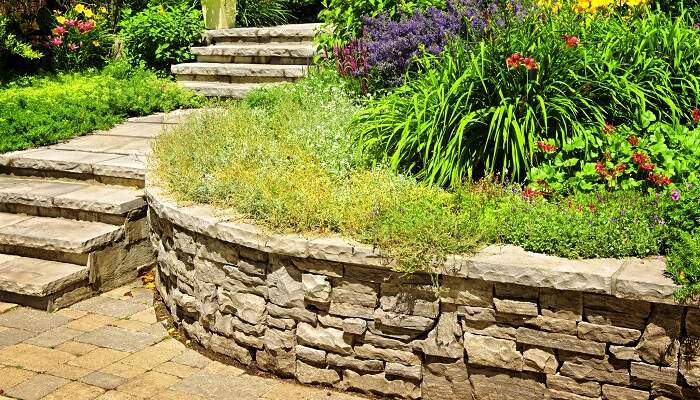In the intricate world of landscape design, the choice of a retaining wall may seem like a minor detail, yet it can significantly impact the overall aesthetic and functionality of your outdoor space. Serving as a crucial support structure, retaining walls can transform a mundane hill into an engaging terrace or prevent soil erosion in your beloved garden. The decision process is far from simple; it involves a careful evaluation of your landscape’s needs, a thoughtful exploration of materials available, a consideration of your preferred design aesthetic, and an understanding of the maintenance requirements. As we embark on this comprehensive guide, we invite you to broaden your perspective on retaining walls – moving beyond their mere functionality to appreciate their potential in enhancing the beauty and versatility of your landscape.
Understanding Retaining Wall Functionality
To fully appreciate the aesthetic and practical impact of a retaining wall in your landscape, one must delve into understanding its core functionality. Retaining walls transcend their primary role of holding back soil and preventing erosion; they are also pivotal in structuring and beautifying an area. They can create leveled spaces on sloping land, enabling further usage such as gardens or patios, or serve as an eye-catching feature that adds value to your property.
The effectiveness of a retaining wall relies on its ability to withstand the lateral pressure exerted by the soil it holds back. This is influenced by various factors – the type and weight of the soil, the slope of the land, and the level of ground water. An effective retaining wall system must also provide adequate drainage to prevent water build-up, which can lead to wall failure.
Understanding these fundamental aspects is key to choosing the right retaining wall for your landscape. It not only ensures structural integrity but also helps to preserve the aesthetic allure of your environment. In essence, the utility of a retaining wall is as profound as its visual appeal.
Evaluating Your Landscape’s Needs
Having grasped the essential functionality of retaining walls, let’s shift our attention towards evaluating your specific landscape needs, a crucial step that ultimately determines the type, design, and placement of your retaining wall.
Begin by considering the topography of your land. Is it steep or gently sloping? A steep slope may necessitate a taller, more robust wall, while a gentle gradient might be best suited for a series of smaller terraced walls. The soil type also plays a vital role. Sandy or loamy soils, which are prone to erosion, may require a sturdier wall, whereas clayey soils might demand better drainage systems.
Assess the aesthetic aspects of your landscape. Should your wall blend seamlessly with the natural surroundings or stand out as a distinct architectural feature? The choice of materials – natural stone, brick, timber, or concrete – will be influenced by this decision.
Moreover, consider the functional aspects. Will the wall merely serve as a soil retainment structure, or will it also double up as a planter, a seating area, or an outdoor kitchen space?
Understanding these needs will provide a blueprint for your retaining wall, helping you make informed decisions that enhance not only the utility but also the beauty of your landscape.
Exploring Retaining Wall Materials
Delving into the realm of materials for retaining walls, one quickly discovers a plethora of options, each with its unique aesthetic appeal, durability, and cost-effectiveness. Natural stone, for instance, offers timeless elegance and superior strength, but it requires professional installation and can be expensive.
Concrete blocks, on the other hand, are cost-efficient and easy to work with, making them a popular choice for do-it-yourself enthusiasts. They can be textured and colored to mimic the look of natural stone or left plain for a modern, minimalist aesthetic.
Another versatile option is wood, which can lend a warm, rustic charm to your landscape. However, it’s worth noting that wood, while initially affordable, requires regular maintenance to prevent decay and may not last as long as stone or concrete.
Brick, with its classic, old-world charm, is another material worth considering, especially for traditional or colonial-style landscapes. It’s durable and low maintenance, but its installation can be labor-intensive.
Choosing the Ideal Wall Design
Navigating the myriad of design options for your retaining wall involves not only considering the material but also the architectural style, the functionality, and the overall aesthetic harmony with your landscape.
A well-conceived design can make the difference between a wall that is a striking focal point, and one that blends seamlessly into the background. Take into account the existing elements in your landscape. Is there a style or era your home embodies? Modern structures might benefit from a sleek, minimalist design, while a classic cottage might call for a more rustic, stone wall.
The functionality of the wall is crucial too. Walls can serve as effective boundaries, noise buffers, or even seating areas. If your wall is to perform a double duty, ensure the design can accommodate these needs without compromising stability.
Lastly, the aesthetic harmony is paramount. The wall should complement, not compete with, your landscape. This requires careful selection of color, texture, and scale. If done right, your wall can enhance your outdoor space, creating not just a retaining structure, but a captivating visual element.
Maintenance and Long-Term Considerations
While the design and aesthetic appeal of your retaining wall are undeniably crucial, equally important is giving due consideration to the maintenance aspects and long-term implications of your choice.
The material you choose will greatly impact the level of upkeep required. For instance, timber might offer a rustic charm, but it is susceptible to rot and insect damage over time. Stone, on the other hand, withstands harsh weather conditions, but periodic inspections for loose stones and mortar are a must. If you’re looking for low-maintenance, concrete or vinyl could be viable options.
Besides maintenance, you also need to ponder on the durability and longevity of your chosen material. Will it stand the test of time and continue to support your landscape in the years to come? Does it offer sustainable benefits, in terms of being environment-friendly or cost-effective?
Moreover, local climatic conditions and the inherent soil type of your region will also influence the performance and lifespan of your wall. A professional consultation can help you navigate these considerations effectively, ensuring your retaining wall not only enhances your landscape’s beauty but remains an enduring and efficient component of your outdoor space.
Conclusion
In conclusion, the selection of an appropriate retaining wall requires a comprehensive understanding of its functionality, a thorough assessment of landscape needs, an exploration of various materials, and the choice of an ideal design. Additionally, maintenance and long-term considerations play a vital role in ensuring the wall’s sustainability. A well-chosen and well-maintained retaining wall can contribute significantly to the aesthetic appeal and functional efficiency of any landscape.




































